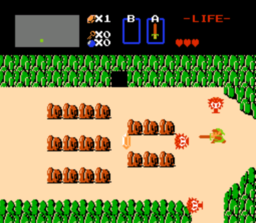It's Dangerous to Go Alone: The History of 'The Legend of Zelda'
Few video games have the power to inspire such unequivocal delight as the "Legend of Zelda" series of video games by Nintendo.
The one that started it all: "The Legend of Zelda" (1986)

It was the mid-1980s, and Shigeru Miyamoto, a game designer at Nintendo in Japan, had just finished work on the third "Donkey Kong" game. He and his team started developing two games at the same time. One was "Super Mario Bros.," a platformer game in which a plumber named Mario must run and jump his way through perilous obstacles in order to rescue a princess.
The other game may have had a similar art style and damsel-in-distress plot point, but was otherwise radically different from the linear, score-driven "Super Mario Bros."
The story goes that Miyamoto was sitting in his office one day when he opened his desk drawer and imagined that there was a miniature garden inside. That thought, along with Miyamoto's childhood memories of exploring the woods around his home, were the seeds that grew into the team's other game: "The Legend of Zelda."
Unlike "Super Mario Bros.," "The Legend of Zelda" was a top-down exploration game that emphasized puzzle-solving instead of fast reflexes. Players could visit the game's eight levels, or "dungeons," in any order they wished, before moving on to rescue Princess Zelda.
MORE: Great Last-Minute Video Game Gifts
The titular princess was named after Zelda Fitzgerald, the American socialite and wife of writer F. Scott Fitzgerald. "I liked the sound of her name," Miyamoto later said in an interview. For the playable character, a green-clad hero tasked with saving Zelda, Miyamoto chose the name Link. Why? Because the character was supposed to be the vessel through which players explored the game's huge, wild world — the "link" between the real world and the magical kingdom of Hyrule.
The game, titled simply "The Legend of Zelda," was released in February 1986 for the Famicom Disc System in Japan. Players were awed by and delighted with the game's nonlinear structure and (for the time) huge open world. Today, fans still quote the game's now-iconic opening scene, in which a wizard gives Link a sword and sends him off with the words "It's dangerous to go alone. Take this."
Today, you can still purchase "The Legend of Zelda" through the Nintendo Virtual Console (a part of the Wii Shop Channel and Nintendo eShop) for the Wii, Wii U and Nintendo 3DS.
Current page: Legend of Zelda History: The first 'The Legend of Zelda' - Tom's Guide
Prev Page History of 'The Legend of Zelda' Video Games - Tom's Guide Next Page Legend of Zelda History: 'The Adventure of Link' - Tom's GuideSign up to get the BEST of Tom's Guide direct to your inbox.
Get instant access to breaking news, the hottest reviews, great deals and helpful tips.
Jill Scharr is a creative writer and narrative designer in the videogame industry. She's currently Project Lead Writer at the games studio Harebrained Schemes, and has also worked at Bungie. Prior to that she worked as a Staff Writer for Tom's Guide, covering video games, online security, 3D printing and tech innovation among many subjects.
-
Warsaw Whaa...you don't include little articles about Wind Waker, Twilight Princess or Skyward Sword? Though they are not as impactful as the others I still believe them to be worth at least a short article each.Reply -
knowom The adventure of Link was actually my favorite Zelda game was a bit like Nintendo's version of a Konami Castlevania game or a bit like Metroid with a rpg theme as opposed to sci-fi.Reply -
tobalaz A Link to the Past was my all time favorite Zelda.Reply
I've played LttP through so many times as a kid I've got every boss and item location still burned into my memory!
Good times.
Zelda never really felt the same again after that.
